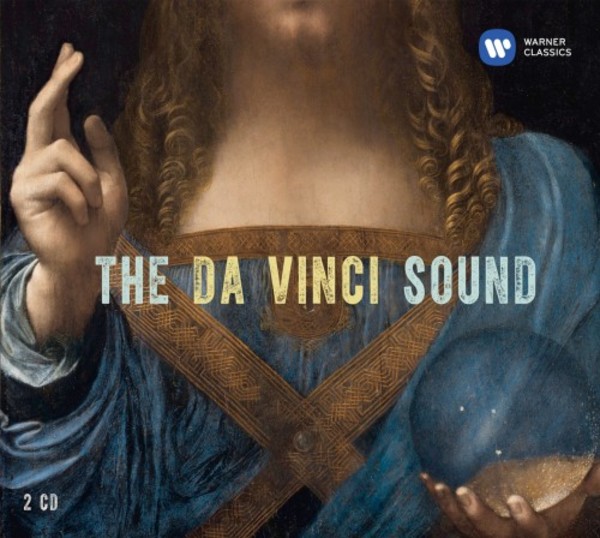
The Da Vinci Sound
£11.88
Usually available for despatch within 5-8 working days
Despatch Information
This despatch estimate is based on information from both our own stock and the UK supplier's stock.
If ordering multiple items, we will aim to send everything together so the longest despatch estimate will apply to the complete order.
If you would rather receive certain items more quickly, please place them on a separate order.
If any unexpected delays occur, we will keep you informed of progress via email and not allow other items on the order to be held up.
If you would prefer to receive everything together regardless of any delay, please let us know via email.
Pre-orders will be despatched as close as possible to the release date.
Label: Warner
Cat No: 9029550696
Format: CD
Number of Discs: 2
Release Date: 1st February 2019
Contents
Works
La voltaUne foys avant que morir
Venise
Amours mercy de trespout non pooir
Triste plaisir et douloureuse joie
Adieu mes amours
Ave Maria...Virgo serena
El grillo
In te, Domine, speravi
La Deploration sur la mort de Johannes Ockeghem
Scaramella va alla guerra
Je me complains pitieusement
Missa L'homme arme
En vray amoure
Pastime with good company
The Fairie-Round
La spagna for 2 lutes
Recercate concertante
Ma bouche rit
Requiem
Palestrina, Giovanni Pierluigi da
Missa Papae MarcelliAdoro te, Domine Jesu Christe
Inter vestibulum et altare
Danserye (selection)
Danserye
Spem in alium (40-part motet)
Ultimi mei suspiri
Artists
Paul Elliott (tenor)Martyn Hill (tenor)
Christopher Hogwood (organ)
Paul O’Dette (lute)
Konrad Ragossnig (lute)
Geoffrey Shaw (bass-baritone)
Hopkinson Smith (lute)
Hanni Widmer (organ)
Choir of King’s College Cambridge
Early Music Consort of London
Ensemble Gilles Binchois
The Hilliard Ensemble
The King’s Singers
Ricercare-Ensemble fur Alte Musik Zurich
Taverner Choir
Taverner Consort
Taverner Consort
Conductors
Paul HillierPhilip Ledger
David Munrow
Andrew Parrott
Anthony Rooley
Dominique Vellard
David Willcocks
Works
La voltaUne foys avant que morir
Venise
Amours mercy de trespout non pooir
Triste plaisir et douloureuse joie
Adieu mes amours
Ave Maria...Virgo serena
El grillo
In te, Domine, speravi
La Deploration sur la mort de Johannes Ockeghem
Scaramella va alla guerra
Je me complains pitieusement
Missa L'homme arme
En vray amoure
Pastime with good company
The Fairie-Round
La spagna for 2 lutes
Recercate concertante
Ma bouche rit
Requiem
Palestrina, Giovanni Pierluigi da
Missa Papae MarcelliAdoro te, Domine Jesu Christe
Inter vestibulum et altare
Danserye (selection)
Danserye
Spem in alium (40-part motet)
Ultimi mei suspiri
Artists
Paul Elliott (tenor)Martyn Hill (tenor)
Christopher Hogwood (organ)
Paul O’Dette (lute)
Konrad Ragossnig (lute)
Geoffrey Shaw (bass-baritone)
Hopkinson Smith (lute)
Hanni Widmer (organ)
Choir of King’s College Cambridge
Early Music Consort of London
Ensemble Gilles Binchois
The Hilliard Ensemble
The King’s Singers
Ricercare-Ensemble fur Alte Musik Zurich
Taverner Choir
Taverner Consort
Taverner Consort
Conductors
Paul HillierPhilip Ledger
David Munrow
Andrew Parrott
Anthony Rooley
Dominique Vellard
David Willcocks
About
‘Leonardo da Vinci (1452–1519), who painted the “Mona Lisa" and “The Last Supper”, was also a designer of ingenious devices, and intensely interested in music – especially with technical improvements to instruments, such as the first valve systems for wind instruments and the idea of an “endless bow” for stringed instruments. As always, Leonardo was way ahead of his time with such ideas, while the music of his era was marked more by an intellectual energy located between the sacred and secular, juxtaposing musical refinement of divine worship and courtly culture.
‘Musical developments in the years 1500 to 1600 were spearheaded by several generations of the “Franco-Flemish School”. Their historic contribution was the development of the art of polyphonic vocal composition featuring imitatory, that is to say canon-like part-writing. This method was employed in church in the motet genre to set sacred Latin verses, while in the royal palaces this form developed into the vernacular madrigal – a vocal genre based on love poetry or verse describing nature, often with an erotic undertone.
‘The best known of these Franco-Flemish composers, Guillaume Dufay, Gilles Binchois, Johannes Ockeghem and Josquin des Prez, all came from the old region of Burgundy between Lorraine, Luxembourg, France and Flanders. They all travelled widely to other European countries, sharing their art with colleagues.
‘England and the Papal See in Rome were both pivotal in this development. One sacred work that owes its genesis to those composers from the Netherlands and their desire to travel round Europe is the Mass for Pope Marcellus II written in 1562 by Giovanni Perluigi da Palestrina using precisely those Franco-Flemish techniques. In the secular field of music master composers such as Francesco da Milano and the Spaniard Juan del Encina applied the same techniques in works for the fashionable instrument of the day, the lute. Even members of the aristocracy and royalty were known to put pen to paper to compose music: King Henry VIII for example, famous for having two of his six wives beheaded, composed love songs for his court.
‘One technical innovation which Leonardo da Vinci would have considered very useful and which marked the first step towards mass distribution of music was the printing of sheet music using movable type, the counterpart to Johannes Gutenberg’s book-printing press, developed by the Venetian-by-choice Ottaviano dei Petrucci (1466–1539). As a result of this innovation, it was then possible to print masses, motets and madrigals and to distribute them widely, as well as to finally annotate and print a wealth of music that had been handed down through generations: dance music. Consequently, the “sound” of the Leonardo era was enriched by many printed scores, making it the first really well researched period of classical music.’
Error on this page? Let us know here
Need more information on this product? Click here